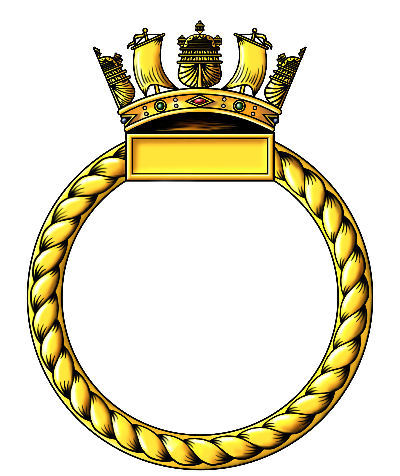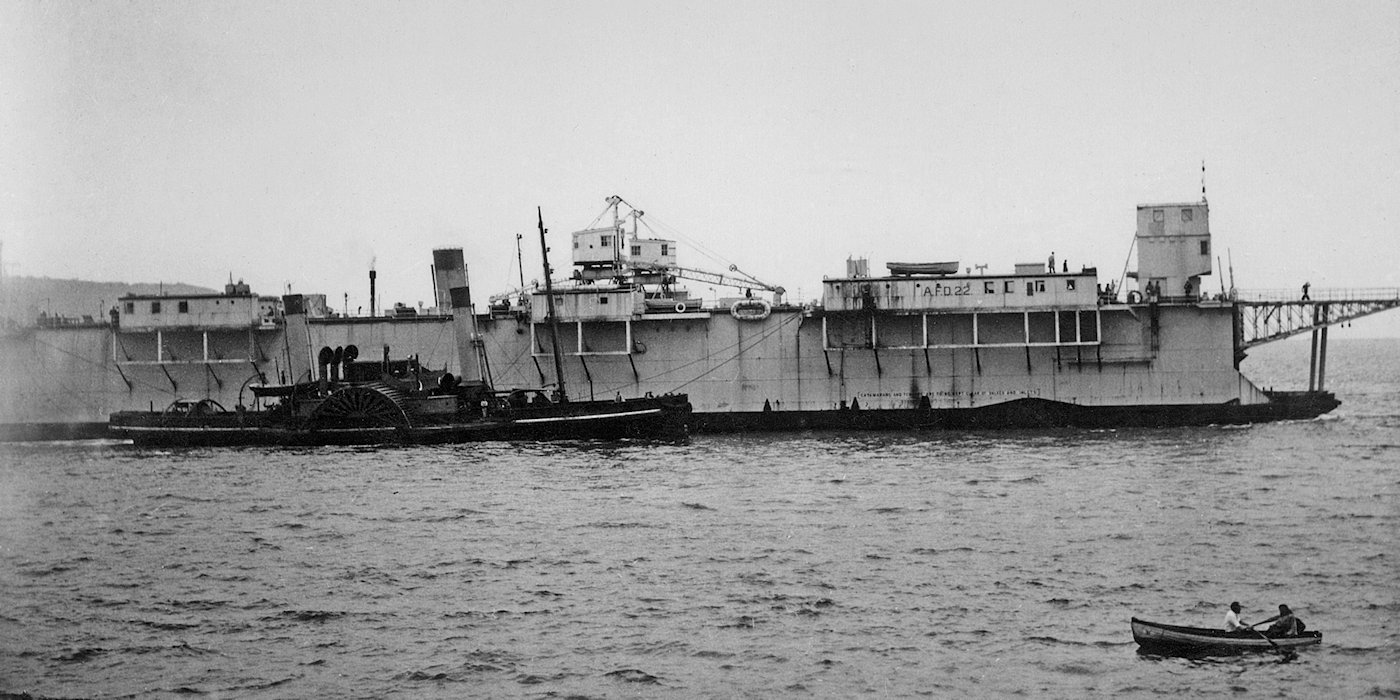Admiralty Floating Dock

Battle Honours
None
Specifications
Builder: Chatham Naval Dockyard, Kent, England
Length: Overall - 380 ft; Pontoons - 350 ft
Width: 50 ft internal
Lifting Capacity: 2,775 tons
Crew complement: 35
Commanding Officers
Lt. Cullen
Lt. Commander Tilsley RN
Related items
None
Reminiscences
None
A.F.D. 22

A 2,750 tons lifting capacity Clark Stanfield design dock
Early history
Admiralty Floating Dock No 22 was built by Chatham Naval Dockyard to a Clark Stanfield design with a lifting capacity of 2750 tons, originally intended for the emergency docking of escort vessels and destroyers. she was launched from No.8 Slip December 7th 1942. On completion she was towed to Rosyth.
AFD 22 was allocated to the Coastal Forces Training Base HMS ST. CHRISTOPHER at Fort William to provide on site dry docking facilities for the large collection of small craft operated by the base. The dock was moored at Corpach in Loch Linnhe, where the base maintenance facilities were located. Her first docking was the Boom Defence trawler HMT MOUNT ARD on August 30th. HMS ST. CHRISTOPHER paid off in December 1944 but the dock remained on station.
Allocated to the East Indies Fleet
AFD22 was allocated to serve with the East Indies Fleet, and it was intended that she be based at Durban, South Africa (her crew thought they might be going to Australia). The dock left Corpach to begin her long ocean voyage on July 27th 1945, under tow by the tug ENIGMA, a sea-going rescue tug. Disaster struck off the coast of Portugal during a violent storm, the tow parted and the dock was adrift in the main shipping lanes until the weather abated enough to re-establish the tow; she arrived at Gibraltar on August 12th 1945. Departing from Gibraltar on August 18th the dock narrowly missed second disaster while transiting the Bay of Tunis where the tidal current sucked the dock into a minefield; the crew of the ENIGMA managed to navigate them out safely and arrived at Port Said on September 3rd. On September 6th the journey continued as the dock entered the Suez Canal, for this leg an additional tug was attached astern.
Passage down the Red Sea took eleven days; the party arrived at Aden on September 17th where she remained, moored to a buoy, for the next two weeks. By now her orders had changed, her operational base was now to be Trincomalee, Ceylon and the journey resumed on October 3rd, AFD22 arrived at Trincomalee on October 26th after making a brief call at Colombo.
Post War
Vessels known to have been lifted by AFD22 while at Trincomalee during 1946 include:
Destroyer HMS VAN GALEN, docked on February 19th, undocked March 6th.
Boom vessel HMS BARLANE and Tug HMS EMPIRE RUTH docked (not before March 12th) undocked March 27th
Destroyer HMS VAN GALEN re-docked on March 28th, undocked April 12th
Trawlers MAGNOLIA and FARA docked on April the 16th, undocked April 23rd.
Frigate LOCH CRAGGIE docked April 26th, undocked April 29th.
Tugs EMPIRE BARBARA and SOPHY were docked May 20th undocked May 30th.
Tug HMS EMPIRE JENNY docked May 30th.
Names and dates taken from the wartime diary of CMX748295, Chief Shipwright Harry E. V. French
Return to the UK
At the start of 1947 AFD22 was earmarked for return to the UK and she departed Trincomalee undertow in early spring; she reached Port Said before being laid up to await an ongoing tow. This came along in late April when AFD22 joined the ships of Operation 'Snow-White' - an unofficial name for a Bombay to Plymouth towing voyage for AFDs 26 and 35 (bound for Malta).
The convoy sailed from Port Said for Malta at 0430 on April 29th. There were four separate tows, (AFD35 had been separated into two section for passage through the canal) employing eight tugs and two escorts - H.M. frigates ST. AUSTEL BAY and WIDEMOUTH BAY. On May 8th the two sections of AFD35 detached from the group to enter Grand Harbour, Malta, "Snow-white" now reduced to two destroyers, two docks (AFDs 22 and 26), five tugs and one escort, continued to Gibraltar after the tugs had taken on fuel at Malta. History seemed to repeat itself on the next leg; a full easterly gale, gusting to force 11 at times, hit the small group of ships that blew for forty-eight hours, both tows broke away, leaving the docks to drift until the weather moderated. Eventually the tows were re-established and reached the docks reached Gibraltar without further trouble. After some repairs, the group set out on the final leg on May 30th, a third small FD (number unknown) joined them. More bad weather plagued them on and off for the next 12 days, one tow parted but this was quickly recovered. All ships arrived at Plymouth on June 10th 1947.
After repairs it was intended that she should go to Sheerness, however, as before, this was changed and she was re-allocated to Kames Bay, the island of Bute, to replace AFD7. She arrived on station at the end of 1947 and was used primarily for docking submarines. Her first lift was HMS ARTFUL on March 22nd 1948. The last docking was HMS SCOTSMAN on October 14th 1956. AFD22 next moved to Falmouth, arriving on November 20th 1956, but moved again less than a year later on October 5th 1957, to Sheerness where she replaced AFD12. AFD22 made one final move on the 21st of September 1959 leaving Sheerness for Rosyth where she remained until 1981 when she was put up for disposal.
She was bought by Husband's Shipyard and was taken to Southampton. She was sold on again in 1983 to the Italian company Cantiere E. Noe, Augusta, Sicily.
Last modified: 23 February 2023
Primary information sources

Comments (0)